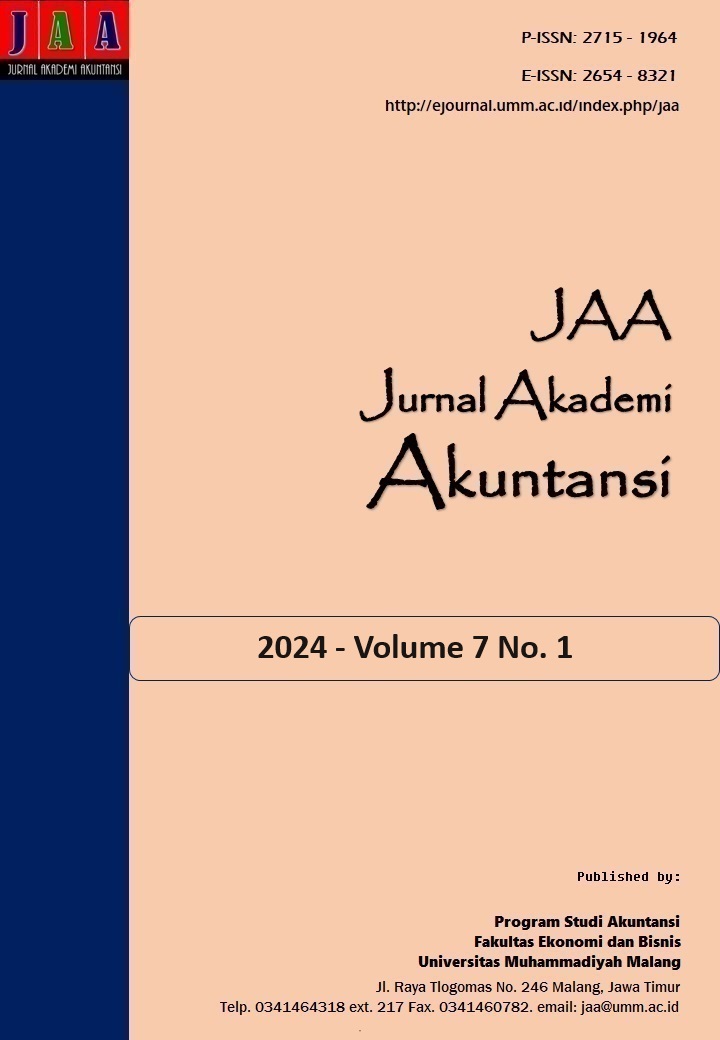E-Finance: What Factors Affect Financial Staff's Motivation to Utilize It?
DOI:
https://doi.org/10.22219/jaa.v7i1.31173Keywords:
E-Finance, Government, Technology Acceptance Model (TAM), Theory of Planned BehaviorAbstract
Purpose: The objective of this study is to investigate the factors that influence the intention of financial staff in the SKPDs of Malang City government to adopt e-finance. This study combines elements from the Technology Acceptance Model (TAM) and the Theory of Planned Behavior (TPB) found in previous research.
Methodology/approach: The survey method was utilized, with a sample of 155 respondents consisting of auditors employed in the financial department of Malang City's government. Data analysis was conducted using Partial Least Square (PLS) method.
Findings: The study's results indicate that constructs like perceived ease of use, perceived usefulness, attitude, subjective norm, and perceived behavioral control have a positive impact on behavioral intention. Additionally, behavioral intention positively correlates with the actual behavior of financial staff using e-finance.
Practical and Theoretical contribution/Originality: The study underscores the significance for e-finance providers and management to consider perceived ease of use, perceived usefulness, attitude, subjective norm, perceived behavioral control, behavioral intention, and the actual behavior of users.
Research Limitation: The researcher acknowledges specific limitations inherent in this study. These constraints pertain to the dissemination of questionnaires to respondents. The researcher encountered restrictions related to regulatory boundaries that define the scope and openness of the research.
Downloads
References
Adrianto, A. & Hidayat, R. (2022). Pengguna Bisnis Start up di Indonesia. Sinashtek: Prosiding Seminar Nasional Sosial, Humaniora, dan Teknologi, Juli (2022), page 858-861.
Ajzen, I. (1985). From intentions to actions: A theory of planned behavior. In Action control: From cognition to behavior (pp. 11–39). Springer. https://doi.org/10.1007/978-3-642-69746-3_2
Ajzen, I. (1991). The theory of planned behavior. Organizational Behavior and Human Decision Processes, 50(2), 179–211. https://doi.org/10.1016/0749-5978(91)90020-T
Alvianto, M. N. H., Adam, N. P., Sodik, I. A., Sediyono, E., & Widodo, A. P. (2022). Dampak Dan Faktor Kesuksesan Penerapan Enterprise Resource Planning Terhadap Kinerja Organisasi: Sistematic Literature Review. Jurnal Nasional Teknologi Dan Sistem Informasi – 07(03), 172-180. https://doi.org/10.25077/TEKNOSI.v7i3.2021.172-180
Armitage, C. J., & Conner, M. (2001). Efficacy of the theory of planned behaviour: A meta‐analytic review. British Journal of Social Psychology, 40(4), 471–499. https://doi.org/10.1348/014466601164939
Assadi, Vahid and Hassanein, Khaled, Continuance. (2010). Intention to use High Maintenance Information Systems: The Role of Perceived Maintenance Effort. ECIS 2010 Proceedings. 88. https://aisel.aisnet.org/ecis2010/88
Baker, R. K., & White, K. M. (2010). Predicting adolescents’ use of social networking sites from an extended theory of planned behaviour perspective. Computers in Human Behavior, 26(6), 1591–1597. https://doi.org/10.1016/j.chb.2010.06.006
Beck, L., & Ajzen, I. (1991). Predicting dishonest actions using the theory of planned behavior. Journal of Research in Personality, 25(3), 285–301. https://doi.org/10.1016/0092-6566(91)90021-H
Buchan, A., LeCleir, G. R., Gulvik, C. A., & González, J. M. (2014). Master recyclers: features and functions of bacteria associated with phytoplankton blooms. Nature Reviews Microbiology, 12(10), 686–698. https://doi.org/10.1128/CMR.00003-14
Chen, B., Sivo, S., Seilhamer, R., Sugar, A., & Mao, J. (2013). User acceptance of mobile technology: A campus-wide implementation of Blackboard’s MobileTM learn application. Journal of Educational Computing Research, 49(3), 327–343. https://doi.org/10.1080/02642069.2011.622369
Chen, S. W.-H., & Davenport, D. S. (2005). Cognitive-Behavioral therapy with Chinese American clients: Cautions and modifications. Psychotherapy: Theory, Research, Practice, Training, 42(1), 101. https://doi.org/10.1037/0033-3204.42.1.101
Cheung, F. Y. M., & To, W. M. (2016). A Customer-Dominant Logic on Service Recovery and Customer Satisfaction. Management Decision, 54, 2524-2543.
https://doi.org/10.1108/MD-03-2016-0165
Davis, F. D., Bagozzi, R. P., & Warshaw, P. R. (1989). User acceptance of computer technology: A comparison of two theoretical models. Management Science, 35(8), 982– https://doi.org/1003. 10.2307/249008
Engwanda, M. N. (2015). Mobile Banking Adoption in the United States: A Structural Equation Modeling Analysis. International Journal of E-Services and Mobile Applications (IJESMA), 7(3), 18-30. https://doi.org/10.4018/IJESMA.2015070102
Fan, B., & Luo, J. (2014). Benchmarking scale of e-government stage in Chinese municipalities from government chief information officers’ perspective. Information Systems and e-Business Management, 12, 259-284. https://doi.org/10.1007/s10257-013-0225-0
Huang, C. C., Wang, Y. M., Wu, T. W., & Wang, P. A. (2013). An Empirical Analysis of the Antecedents and Performance Consequences of Using the Moodle Platform. International Journal of Information and Education Technology, Vol. 3, No. 2, April 2013. https://doi.org/10.7763/IJIET.2013.V3.267.
Huang, Y., Russell, W. K., Wan, W., Pai, P.-J., Russell, D. H., & Liu, W. (2010). A convenient method for genetic incorporation of multiple noncanonical amino acids into one protein in Escherichia coli. Molecular BioSystems, 6(4), 683–686. https://doi.org/10.1039/B920120C
Jafarkarimi, H., Saadatdoost, R., Sim, A. T. H., & Hee, J. M. (2016). Behavioral intention in social networking sites ethical dilemmas: An extended model based on theory of planned behavior. Computers in Human Behavior, 62, 545–561. https://doi.org/ 10.1016/j.chb.2016.04.024
Jogiyanto, H. M. (2007). Model kesuksesan sistem teknologi informasi. Yogyakarta: Penerbit Andi.
Karahanna E, Agarwal R, Angst C. (2006). Reconceptualizing compatibility beliefs in technology acceptance research. MIS Q., 30, 781-804. https://doi.org/ 10.2307/25148754
Kim, J., & Gambino, A. (2016). Do we trust the crowd or information system? Effects of personalization and bandwagon cues on users’ attitudes and behavioral intentions toward a restaurant recommendation website. Computers in Human Behavior, 65, 369–379. https://doi.org/10.1016/j.chb.2016.08.038
Lam, T., Cho, V., & Qu, H. (2007). A study of hotel employee behavioral intentions towards adoption of information technology. International Journal of Hospitality Management, 26(1), 49–65. https://doi.org/10.1016/j.ijhm.2005.09.002
Lathrop, D., & Ruma, L. (2010). Open government: Collaboration, transparency, and participation in practice. O'Reilly Media, Inc.
Lee, C. J., Geiger-Brown, J., & Beck, K. H. (2016). Intentions and willingness to drive while drowsy among university students: An application of an extended theory of planned behavior model. Accident Analysis & Prevention, 93, 113–123. https://doi.org/10.1108/09590550510581485
Mahardhika, A. S. (2019). Akuntan di Era Digital: Pendekatan TAM (Technology Acceptance Model) Pada Software Berbasis Akuntansi. Jurnal Ilmiah Akuntansi dan Keuangan, 8(1), 12-16. https//doi.org/10.32639/jiak.v8i1.282
Nasri, W., & Charfeddine, L. (2012). Factors affecting the adoption of Internet banking in Tunisia: An integration theory of acceptance model and theory of planned behavior. The Journal of High Technology Management Research, 23(1), 1–14. https://doi.org/10.1016/j.hitech.2012.03.001
Özer, G., & Yilmaz, E. (2011). Comparison of the theory of reasoned action and the theory of planned behavior: An application on accountants’ information technology usage. African Journal of Business Management, 5(1), 50–58. https://doi.org/10.5897/AJBM10.389
Ramayah, T., Rouibah, K., Gopi, M., & Rangel, G. J. (2009). A decomposed theory of reasoned action to explain intention to use Internet stock trading among Malaysian investors. Computers in Human Behavior, 25(6), 1222–1230. https://doi.org/10.1016/j.chb.2009.06.007
Sayekti, F., & Putarta, P. (2016). Penerapan Technology Acceptance Model (TAM) dalam pengujian model penerimaan sistem informasi keuangan daerah. Jurnal Manajemen Teori dan Terapan, 9(3), 196-209. https://doi.org/10.20473/jmtt.v9i3.3075
Shih, Y., & Fang, K. (2004). The use of a decomposed theory of planned behavior to study Internet banking in Taiwan. Internet Research, 14(3), 213–223. https://doi.org/10.1108/10662240410542643
Shropshire, J., Warkentin, M., & Sharma, S. (2015). Personality, attitudes, and intentions: Predicting initial adoption of information security behavior. computers & security, 49, 177-191. https://doi.org/10.1016/j.cose.2015.01.002
Taylor, S., & Todd, P. (1995). Decomposition and crossover effects in the theory of planned behavior: A study of consumer adoption intentions. International Journal of Research in Marketing, 12(2), 137–155. http://dx.doi.org/10.1016/0167-8116(94)00019-K
Tseng, K.-H., Chang, C.-C., Lou, S.-J., & Chen, W.-P. (2013). Attitudes towards science, technology, engineering and mathematics (STEM) in a project-based learning (PjBL) environment. International Journal of Technology and Design Education, 23, 87–102. https://doi.org/10.1007/s10798-011-9160-x
Ulum, M. C. (2018). Public Service (Tinjauan Teoritis dan Isu – Isu Startegis Pelayanan Publik). Malang: UB Press.
Venkatesh, V., & Davis, F. D. (2000). A theoretical extension of the technology acceptance model: Four longitudinal field studies. Management Science, 46(2), 186–204. https://doi.org/10.1287/mnsc.46.2.186.11926
Wang, J.-Y., Chuang, H.-N., Chiu, J.-H., Fu, S.-L., Tsai, T.-H., Tsou, A.-P., Hu, C.-P., Chi, C.-W., Yeh, S.-F., & Lui, W.-Y. (2006). Effects of Scutellaria baicalensis Georgi on macrophage-hepatocyte interaction through cytokines related to growth control of murine hepatocytes. Experimental Biology and Medicine, 231(4), 444–455. https://doi.org/10.1177/153537020623100410
Widya, K. A., Zaki, B., & Bambang, H. (2017). Study on auditor’s attitude in using information technology for auditing: Theory of planned behavior and social cognitive theory modification. Russian Journal of Agricultural and Socio-Economic Sciences, 66(6), 250–258. https://doi.org/10.18551/rjoas.2017-06.29
Yang, H., Song, H., Cheung, C., & Guan, J. (2021). How to enhance hotel guests’ acceptance and experience of smart hotel technology: An examination of visiting intentions. International Journal of Hospitality Management, 97, 103000. https://doi.org/10.1016/j.ijhm.2021.103000
Zha, X., Li, J., & Yan, Y. (2013). Information self-efficacy and information channels: Decision quality and online shopping satisfaction. Online Information Review, 37(6), 872–890. https://doi.org/10.1108/OIR-09-2012-0156
Downloads
Published
Issue
Section
License
Copyright (c) 2024 Muhammad Dimar Alam, Areta Widya Kusumadewi, Laila Fitriyah LH

This work is licensed under a Creative Commons Attribution-NonCommercial-ShareAlike 4.0 International License.
Jurnal Akademi Akuntansi is licensed under a Creative Commons Attribution-NonCommercial-ShareAlike 4.0 International License.
Authors who publish with this journal agree to the following terms:
- Authors retain copyright and grant the journal right of first publication with the work simultaneously licensed under a Creative Commons Attribution-NonCommercial-ShareAlike 4.0 International License that allows others to share the work with an acknowledgment of the work's authorship and initial publication in this journal.
- Authors are able to enter into separate, additional contractual arrangements for the non-exclusive distribution of the journal's published version of the work (e.g., post it to an institutional repository or publish it in a book), with an acknowledgment of its initial publication in this journal.
- Authors are permitted and encouraged to post their work online (e.g., in institutional repositories or on their website) prior to and during the submission process, as it can lead to productive exchanges, as well as earlier and greater citation of published work (See The Effect of Open Access).
Jurnal Akademi Akuntansi dilisensikan di bawah lisensi Creative Commons Attribution-NonCommercial-ShareAlike 4.0 International.
Penulis yang menerbitkan artikel di jurnal ini menyetujui ketentuan berikut:
- Penulis mempertahankan hak cipta dan memberikan hak jurnal atas publikasi pertama dengan karya yang secara serentak dilisensikan di bawah Lisensi Pengaitan Creative Commons yang memungkinkan orang lain untuk berbagi karya dengan pengakuan atas karya penulis dan publikasi awal dalam jurnal ini.
- Penulis dapat masuk ke dalam pengaturan kontrak tambahan yang terpisah untuk distribusi non-eksklusif versi karya jurnal yang diterbitkan (misalnya, mempostingnya ke repositori institusional atau mempublikasikannya dalam sebuah buku), dengan pengakuan publikasi awalnya di jurnal ini.
- Penulis diizinkan dan didorong untuk memposting pekerjaan mereka secara online (misalnya, di repositori institusional atau di situs web mereka) sebelum dan selama proses pengajuan, karena dapat mengarah pada pertukaran produktif, serta kutipan pekerjaan sebelumnya dan yang lebih besar (Lihat Pengaruh Akses Terbuka).
























